Plasma Physics
We are generally interested in the science and applications of the ionized gases that are often called Technological Plasmas. Such plasmas have applications as diverse as light sources, large display televisions, medical instruments, and a variety of material processing systems.
From both scientific and technological viewpoints, a key feature of the plasmas that we study are that they are far from thermodynamic equilibrium, which means that the atoms and molecules in the background gas have a much lower temperature than any ions and electrons present in the ionized gas.
Our research is concerned with fundamental studies of these plasmas, and development of measurement techniques to monitor and control them
Applications of plasma measurements to monitoring and control
• Electrical measurements based on electrostatic probes (an RF-biased ion flux sensor, charged particle analysers and Langmuir probes) and electromagnetic probes (hairpin resonator)
• Time and space resolved optical emission studies
• Spectroscopic measurements of electric fields
Electric field measurements methods
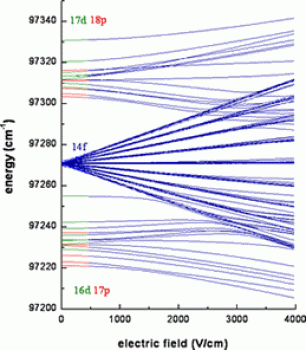
The aim of this project is to develop laser-based methods of measuring electrics fields that can be applied in studies of low-pressure plasmas. The study focuses on Stark spectroscopy of noble gases such as argon, krypton and particularly xenon.
We use laser induced fluorescence and laser optogalvanic spectroscopy to detect Stark effects in the atomic species. On addition, we use a theoretical calculation of Stark effects in noble gases to predict the effects of electric fields on high-lying Rydberg states of these atoms.
Experiments are performed at Eindhoven University of Technology, Netherlands.
Collaborative partners include Erik Wagenaars, Tao Jiang, and Gerrit Kroesen at Eindhoven University of Technology. Funding comes from the NWO/STW funding bodies in the Netherlands.
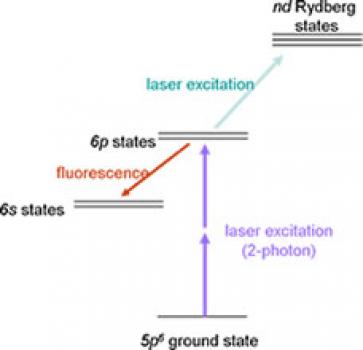 Dependence of particular Xe energy levels on electric field, as determined by a quantum mechanical calculation based on perturbation theory. The result shows how the energy levels change at low electric fields and then intermix completely at higher fields.
Dependence of particular Xe energy levels on electric field, as determined by a quantum mechanical calculation based on perturbation theory. The result shows how the energy levels change at low electric fields and then intermix completely at higher fields.
Excitation scheme used to experimentally probe the nd Rydberg states of xenon.
The 2-photon excitation requires laser wavelengths of about 250 nm. The second laser excitation to the Ryderg states requires wavelengths in the range of 550-600 nm.
Fluorescence is monitored on the 828 nm transition from the 6p intermediate state to a 6s state.
Free plasma boundaries
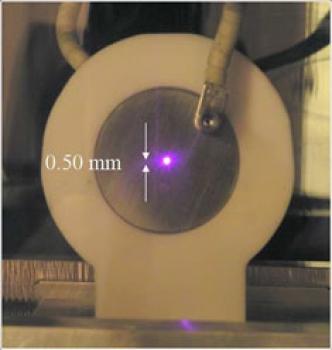 The aim of this project is to understand the boundaries of plasmas that are not contained in a vessel ? in particular the boundary between a atmospheric plasma and the background atmosphere itself.
The aim of this project is to understand the boundaries of plasmas that are not contained in a vessel ? in particular the boundary between a atmospheric plasma and the background atmosphere itself.
This experimental study, which started in 2006, focuses on using optical methods such as plasma imaging and laser spectroscopy to visualise the boundary and to provide information on the populations of important species.
In addition, we will use a theoretical calculation of Stark effects in noble gases to predict the effects of electric fields on high-lying Rydberg states of these atoms.
Experiments are performed at the Milton Keynes campus of The Open University. Funding comes from The Open University and the UK funding council EPSRC.
The photograph shows a microhollow cathode discharge, operating with a small flow of helium into the atmosphere. In this case, the region of interest is the transition between the helium plasma and the background atmosphere.
Microplasma from diamond arrays
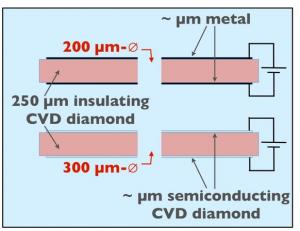
Cross-section of our two main devices, showing the different materials with each corresponding thickness.
We investigate the ignition and instabilities of a sub-millimetre plasma or microplasma. Our main device geometry is a microhollow cathode discharge (MHCD) in which a cylindrical cavity is laser-drilled through a vertical stack of conductor-insulator-conductor. A cross-section for two of our devices is represented in Figure 1.
There is an empirical relationship between the breakdown voltage in a volume confined by two electrodes and the product of their separation and the operating pressure. According to that so called Paschen curve , high pressure operation is compatible with microscopic dimensions. This is the rationale behind microplasma research.
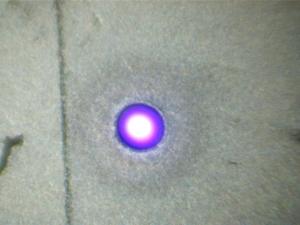
Microplasma in helium at half the atmospheric pressure in the metal-diamond-metal device from Figure 1.
The very high surface to volume ratios suggest an important role for the wall materials. That is the motivation behind our study of diamond-based devices (Figure). By controlling parameters such as the dimensions, diamond semiconductivity, gas pressure we aim to quantitatively describe the plasma-wall interactions.
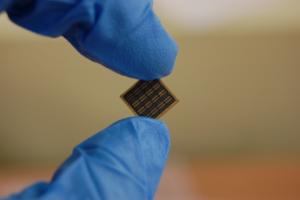
Microchip with a range of single devices and microplasma arrays.
An example of a microplasma at half the atmospheric pressure in helium is shown in Figure 3, in a top view of the metal-diamond-metal device from Figure. We study single devices as well as microplasma arrays. A microchip containing thousands from both types is depicted in Figure.
A myriad of microplasma applications and research projects have been reported, impressive in their number and the range of topics covered.
Plasma ignition/breakdown
The aim of this project is to study the initial stages of plasma ignition – the transition between a gas and a plasma. Basic measurement methods are used, including imaging of plasma emission and also advanced measurement methods such as laser-based measurements of electric field distributions.
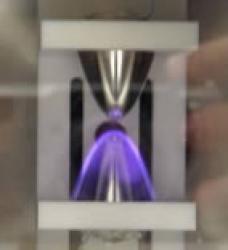
Plasma emission from a steady-state d.c. discharge.
In addition, the ignition process is simulated using md2d, a two-dimensional fluid simulation code at Eindhoven University of Technology.
One part of the study is aimed at understanding ignition in a low pressure discharge, at identifying and understanding the ionization waves that characterise the ignition process. Other parts of the study examine ignition in plasma applications such as plasma display cells and fluorescent lamps. In these case, nearby dielectric surfaces are expected to influence the ignition processes.
Collaborative partners include Erik Wagenaars, Wouter Brok, Tao Jiang, Maxime Gendre, and Gerrit Kroesen at Eindhoven University of Technology, where most experimental work is carried out. Funding comes from the NWO/STW funding bodies in the Netherlands and Philips Lighting (Eindhoven).
In figure, a simple electrode scheme is used to study plasma ignition at low pressure, where the two electrodes have parabolic shape, with the tips being separated by about 3 mm.
.jpg)
